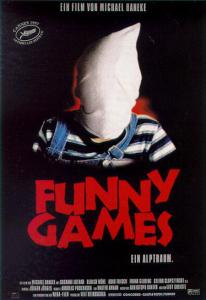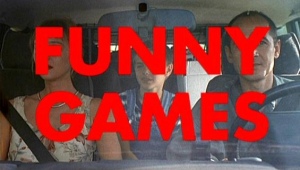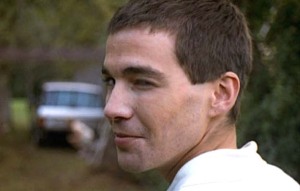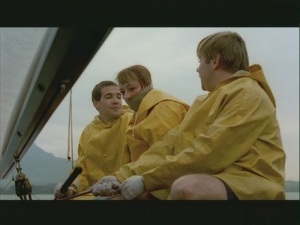In the day and age of countless prequels, reboots, sequels, and indistinguishable blockbusters, no remake stands out quite as curiously as Michael Haneke’s return to his 1997 film Funny Games with his American remake ten years later. Despite the relocation to America with American actors, the two films written and directed by the same filmmaker remain largely identical. For a premise that includes home torture invasion filled with some of the most savage and brutal acts committed to film, one must consider why this subject matter bears such close reexamination and recreation, not just by the filmmaker, but by his audience.
Funny Games revolves around a family—a husband, wife, and son—who arrive upon their vacation home only to be confronted by two upper class, white teenage boys that take the family hostage for a very long and horrible night. The boys engage in a series of eponymous games with the family, forcing their complicity in acts of humiliations, torture, and increasingly repulsive choices which culminates in a cycle of violence that not only comments on the repetition of the horror genre but of the audiences’ desire to seek out such horrors.
Starting with the family’s drive to their new lakeside vacation home, the husband and wife play a game of guessing the title and composer of the classical tracks on their cassette player. This is the first “game” to be played by the couple. As the audience settles into the opening credits, the two tease and joke with one another about their knowledge of these classic musicians. The guessing game plays out slowly, realistically, and arguably—boring. Then, suddenly, the clashing and overbearing heavy metal song “Bonehead” by Naked City plays over this idyllic and peaceful moment. The screaming, discordant vocals of the heavy metal over this smiling family within the comfort of their location (the car) can be befuddling, yet demonstrates exactly what Haneke will prove throughout the rest of the movie—that as much as the audience may wish to identify with this innocent and endearing family, as much as the appeal and elitism of the classical music may delude the audience into believing this is the same type of entertainment that they too enjoy, it is only with the intrusion of the unbelievably loud and attention-seeking heavy metal music that the audience finally starts to truly pay attention…for better or worse.
Haneke leads a small, diminishing group of filmmakers confident enough to play out not just a scene or two, but long sequences out in real-time—allowing the audience to observe the family as they pursue their daily and mundane activities. The father and son prepare their boat for sailing, the mother prepares meat for dinner, the family dog tries stealing food out of the refrigerator—for about fifteen minutes, the audience abides these uneventful and monotonous routines of familial life.
And then, it begins.
While preparing the meat, the first of the two teenage boys—Peter—knocks on the door. Almost instantly, a wave of tension rises over the viewer. These sequences of quiet, familial life suddenly interrupted by a chubby, affable looking teenager asking to borrow eggs. Thinking nothing of it, the mother—Anna—proffers a handful of eggs that the boy accepts. But on the way out, he “clumsily” drops them. Again, he asks for eggs. Though annoyed, she again hands him more of her eggs. But, again, he “drops them”—this time, knocking the house phone into the sink. With her suspicion rising, the second of the two boys—Peter—enters the home looking for his companion. If Paul’s presence weren’t enough to grab both Anna and the audience’s attention that something is wrong, Peter’s introduction wastes no time confirming it. The two boys continue to demand the eggs from Anna, while Peter claims a golf club from her husband’s bag. When she asks the two boys to leave her home, they polite refuse. When she demands that they leave…
They politely refuse.
When the husband and son—George and George J.R.—reenter the home, Peter wastes no time breaking the latter’s kneecap with the purloined golf club—disabling any hope for the family’s escape. And with this, the film enters the very long night of “funny” games perpetuated upon the hostage family. In the first of many gut-punching moments to come, Anna notices that the family’s constantly barking dog has gone quiet—absolutely silent. Fear flashing in her eyes, Peter smiles and escorts her outside and plays a game of “hot and cold” with the distraught mother as to where the dog may be. In between his shouts of “hot” and “cold” as Anna’s nears the inevitable, he turns and winks at the camera—at the audience.
Like with the music in the opening, Haneke again ensures that the audience cannot remain unengaged with this destruction of the fourth-wall. Like it or not, the audience must now understand that they are not a passive observer in the politics of this violent narrative but playing an active—albeit removed—role in the games to follow. Peter has dismantled any illusion that the audience is not a secondary participant to the “entertainment” at hand, and he intends to deliver what is expected in the conclusion of this type of genre entertainment. A moment later, Anna opens the car door and shrieks, as the corpse of the murdered dog falls from the trunk to her feet.
Following up from this, Peter and Paul decide to propose a bet with the family: considering whether or not they will survive until 9:00 AM the next morning. Peter then again turns directly toward the camera to ask: “Do you think they’ve a chance of winning. You’re on their side, aren’t you? So who will you bet with?” Again, Peter digs into the heart of the audience’s question of entertainment. The audience has arrived with certain expectations for a horror/slasher movie, and even in choosing to watch the movie, the audience is essentially “betting” with the filmmaker as to whether or not the characters will survive.
After a few more games—one that includes stripping the mother down to consider whether she is fat while stuffing the son’s head inside a pillowcase—Peter leaves Paul in charges of the family while he returns to the kitchen to make a snack. In the interim, as the young man casually makes his snack, a gunshot is heard off-screen. And then, the horrible shriek of one of the parents, followed by sobs and hysterical tears. When Peter moves back to the living room, the image we are confronted with is bright red blood across the television set. Over this, Peter screams at his companion:
“You’re an idiot, fatty. You don’t shoot the person you counted out, but the one that’s left over! What’s wrong with you? He tried to escape! So what! That’s no reason to get trigger-happy! Have you no sense of timing? It’s only midnight. We’ll get nothing from the others now.”
As the wailing of the mother and father are heard through his tirade, the audience comes to the horrific realization that it is the blood of the small child seen upon that television set. The blood upon the television set of both our literal screen to watch the movie, and the “fictional” set within the living room of the family. Enraged more by his companion’s breaking of the rules than by the death of the child, Peter and Paul decide to leave the home.
With her deceased son at her feet, Anna crouches across the floor in shock. She turns off the TV and—simultaneous with the departure of the boys—the film returns to the feeling of “real-time”. The couple sits. Crying. Nearly catatonic. For the next few long, agonizing minutes, the couple must absorb the fact that their child has died. This long, uncomfortable sequence further demonstrating the gut-wrenching consequences of the sadism so reveled in by the horror genre, but that is usually ignored by the urgency of the plot in so many other slashers and home-invasion movies.
The horror audience (and specifically the slasher subgenre) has come to the film with a certain expectation that have been cleanly setup by the premise. A normal group of people are terrorized by the monster from beyond, some will live, but some will most certainly die. Whether it be Freddy, Jason, or Leatherface, these monsters have created million-dollar franchises on this promise—on this bet with the audience—to see who will make it out alive by the end of the picture’s run time. As body counts escalate with each progressives sequel, the filmmakers seem increasingly less interested in the pathos and possible consequences that arise out of these killers taking a life, rather than exploiting the gore and jump-scares that are promised by the premise.
Moreover, this long sequence between the couple brings the rising horror of the film’s former minutes into a stark and unmistakable reality. For all the viscera and compelling filmmaking that has led the audience to engage with film—to be entertained by it—this family has lost their child. While the viewer may attempt to distance from this death by labeling it fictional, Haneke will addresses this problem through philosophical theory in the following scenes.
After recomposing themselves in the wake of this tragedy, Anna and George summon whatever will is left inside them to try and find help. George blow-dries the phone to call the police, while Anna takes to the streets—literally screaming for help. And of course, this glimmer of hope is quickly shattered. While the slasher’s return to the screen is normally presented as a source of excitement following a interim period of following a group of bland teenagers, the return of Peter and Paul into the home—and holding Anna hostage—the viewer is only left with a feeling of dread and that the worst has yet to come.
Despite killing the child, the teenagers return determined to conclude the bet. The final game involves Anna choosing whether a knife or gun will be her weapon of choice for death. After asking her to choose, with the duct-tape still wrapped around her mouth, Peter releases the tape to remind her:
“It’s boring when mutes suffer. We want to entertain our audience, right? Show them what we can do. We’re gonna play another game. This game is “The Loving Wife…Otherwise, known as whether by knife, or whether by gun, losing your life can sometimes be fun. Come on, don’t fall asleep. You have to play the game or otherwise I have to gag you again.”
Just after the audience has settled into some feeling of normalcy following Anna’s escape, Haneke refuses to let the audience off the hook. Even though Anna, standing in as the audience surrogate, continues to ask why they insist on completing the bet, that they’ve suffered enough. Peter stares at the camera and delivers: “Do you think it’s enough? You want a real ending, right? With plausible plot development, don’t you? The bet is still on.”
Indeed, with the boys’ disappearance following the child’s death, one wonders how the film could possibly continue. With so much running time left and the main agents of “plot” progression through the boys, Funny Games does not have much “entertainment” to pool from moving forward. What if Anna were to find safety? To find police that would resolve the situation? Would the audience claim afterward that this were as anticlimactic as Peter suggests? As the game reaches its climax, with Peter continuing to mock Anna and her husband, she finally does it—Anna grabs the shotgun and shoots Paul in the chest to kill him. Distraught, Peter grabs the shotgun, flips over the pillow couches, looking for…..the remote.
He finds the remote, clicks rewind, and then the film literally begins to rewind—reversing to the moment to just before Anna fired the gun. This time, however, Paul manages to reclaim the weapon and stop her from killing his companion. Although there have been a few fourth-wall breaks listed above, even as intense as Peter directly confronting the camera, this moment is arguably the most destructive and unbelievable. For the second time now, a moment of plausible escape has occurred for Anna. She seizes the moment, killing the film’s agents of violence…
…but it’s taken from her.
As though embodying the very soul of the film, Peter grabs the remote and changes the narrative’s course. He rewinds the timeline, seizes the shotgun, and uses the weapon to kill George. Like a viewer of the horror film, if given the opportunity, Peter is determined for the viewer to be entertained by this premise to maximum degree. In the most extreme version of this scenario imaginable, it means literally taking the film’s narrative into his own hands and changing the actions of the protagonist to ensure that there may be no outcome possible other than the one that causes viewers to be as “entertained” as possible. Though this exact definition remains up for debate, its consequences do not, as detailed in the final scene.
With Anna now the family’s sole survivor, the boys take her out upon the family’s fishing boat. While sailing out to the middle of the vast lake, the boys debate a particular philosophical discussion in a casual manner that may easily slip past the viewer due to its casual delivery and camera’s focus on Anna’s attempt to retrieve a knife in one last hope for escape. The conversation even begins with Paul in mid-sentence, exclaiming:
“And so everything is it’s mirror image, but of course, all these predictions are lies to avoid panic…but the problem isn’t only how to escape the anitmaterial world to go back to the real one but how to communicate between the two worlds…”
Peter then realizes that Anna has seized the hidden knife, and after applauding her “Olympic Spirit”, the two pause their philosophical discussion, check to find that it’s only 8 AM…before then Peter nonchalantly throws Anna over the boat for her to drown in the middle of the lake. The two appear to give little care toward Anna’s quick demise, especially with so much time left in the “bet”, under the excuse that they’re hungry. Docking the boat upon the other side of the lake, however, the two resume that previous discussion:
“Where was I?”
“You were discussing the difference between communicating with the material universe, and antimaterial universe, right”
“It turns out that one universe is real. And one is fiction…it’s a kind of model projection in hyperspace.”
“But where’s your hero now?”
“He’s in reality and he’s in fiction”
“But the fiction’s real…you can see it in the movie right?”
“Of course.”
“Well, then, its’ just as real as reality, ‘cus you can see it, too.”
“Bullshit.”
“Why?”
Here, again, the conversation plays out so seemingly out of context, quick, and cursory that the dialogue may slip past the viewer. However, it holds the key to much of Haneke’s thesis for the violence within not just this movie but horror in a broader context. While the discussion is clearly ambiguous, it also hints toward a theory of fiction that supposes much of the fiction—while existing in a different reality than our own—can still be believed to hold some level of truth. While one may easily scoff at such a theory, perhaps spouting Paul’s reaction: “Bullshit”, Peter/Haneke answers with the simple question of “Why”.
Though answers exists to such an esoteric and abstract theory, the point is to at least consider the consequences of distancing ourselves from such fictional horrors. Numerous times throughout the film, Haneke confronts the viewer about “rooting” for such heinous acts to occur, about accepting such tragedies in the name of entertainment, or attempting to distance ourselves from playing a removed role in the progression of these atrocious acts that occur on the “fictional” screen. Though there will always be violence in fiction—often times playing to discover a larger emotional truth about human nature, but used in equal measure for the shlock value of cheap entertainment thrills—Funny Games is a rare film that uses the genre to both the push the boundaries of such thrills and simultaneously comment on the larger issue of violence in fiction at large.
The film ends with Peter knocking on the resident’s door at this house on the opposite end of the lake. When the woman opens the door, he asks if he can borrow some eggs. She allows him inside the house to wait, and after she leaves, Peter stares directly into the camera for a final look at the audience as the heavy metal of “Naked City” ramps up to full volume again—suggesting the repetitive nature of this fictional cycle of violence. In Haneke’s decision to even repeat making this movie—in painstaking shot for shot recreation—Haneke is challenging repeat viewers for their compulsion to seek out this violence yet again. And not just of this remake, but of this level of violence in a broader fiction.
While many genre fans are often annoyed by movies like this, one as subversive and challenging about the very elements that a viewer has paid to see, Funny Games proves to be one of the most exceptionally crafted and inventive pieces of horror filmmaking to simultaneously push genre boundaries on a narrative level while confronting viewers’ desire to seek out this specific type of “entertainment”. Furthermore, Haneke’s decision to recreate his own movie through a shot-for-shot remake with American actors and setting serves to not only reproduce the entertainment for a new audience but also works as commentary on the continuing cycle of violence within the genre. As usual, Haneke has raised the bar for filmmakers to examine the principles of their work, genre, and purpose of the entertainment in their hands. Going forth, one wonders when other filmmakers may seize the opportunity to examine such a particular, prominent genre through both the narrative and medium as masterfully as Funny Games. As Peter would remind us: “The bet is still on”.







Good commentary! IMO, the real problem – and power – of this movie came from the fact the acting was superb. Everyone, and especially the boy, were right on the money, so it still seemed real no matter how many times they broke the 4th wall.